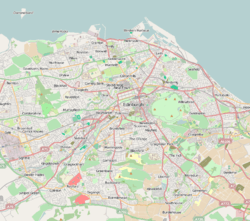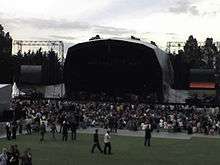Meadowbank Stadium
|
Meadowbank Stadium | |
 Meadowbank Stadium Location in Edinburgh | |
| Former names | New Meadowbank, Old Meadowbank |
|---|---|
| Location | Meadowbank, Edinburgh, Scotland |
| Coordinates | 55°57′25″N 3°9′31″W / 55.95694°N 3.15861°W |
| Type | Outdoor Sports / Concert Stadium |
| Seating type | Individual backed seats in stand, bench seats all other areas |
| Capacity | 5,000 |
| Construction | |
| Built | 1967-1970 |
| Opened | 1970 |
| Renovated | 1994, 1999 |
| Tenants | |
|
Meadowbank Thistle F.C. (1974–1995) Edinburgh City F.C. (1996–present) Edinburgh Rugby (2002–2004) Leith Athletic F.C. (3G pitch, 2013–present) | |
| Website | |
| Edinburgh Leisure | |

Meadowbank Stadium (officially Meadowbank Sports Centre) is a multi-purpose sports facility, with a present capacity of 5,000 seats, located at Meadowbank, in Edinburgh, Scotland. Built on the site of the earlier New Meadowbank and Old Meadowbank sports venues, it was originally built to host the 1970 Commonwealth Games. It also hosted the Games in 1986, becoming the first venue to host the Games twice.
The stadium has also regularly hosted football. It was the home ground of Scottish Football League team Meadowbank Thistle between 1974 and 1995. From 1996, it hosted senior non-league football as the home ground of Edinburgh City. League football returned to Meadowbank in 2016 following City's promotion to the Scottish Professional Football League. The Meadowbank complex also hosts Leith Athletic, who have played on the Meadowbank 3G artificial pitch adjacent to the main stadium since 2013.
Meadowbank Stadium was also used for rugby union as the home venue of Edinburgh Rugby between 2002 and 2004.
Layout
The present capacity of the stadium is 5,000.[1] The stadium consists of a main grandstand, with uncovered benches around the rest of the track. It was built on the site of New Meadowbank stadium, while the indoor sports complex and adjacent pitches to the east were built on the site of Old Meadowbank stadium. The stadium itself contains an eight lane, 400 metre running track, with a grass pitch within this. There is also a velodrome adjacent to the site. Underneath the stand is a covered 100 metre, eight-lane track.
The stadium contains indoor facilities, including squash and basketball courts. These are also used for antiques fairs, martial arts competitions, conferences, and church meetings. Other outdoor facilities include field hockey pitches.
Uses
Commonwealth Games
Meadowbank Stadium was built for the 1970 Commonwealth Games, at a cost of £2.8 million.[2] It was opened by Prince Edward, Duke of Kent on 2 May 1970.[2] The 1970 Games was one of the most successful in the history of the event.[3][4] The 1986 Commonwealth Games were also held at Meadowbank, which became the first venue to host the Commonwealth Games twice.[2] The 1986 Games suffered a financial deficit and were widely boycotted due to the support of the British Government for the apartheid regime in South Africa.[3][4]
Football
Meadowbank Thistle played at the stadium from 1974 until the club relocated to the new town of Livingston in 1995.[5] Meadowbank is often cited as one of the worst stadiums used in the Scottish Football League due to the lack of atmosphere in the ground. This was caused by the stadium having a capacity of 5,000, but Meadowbank typically attracted crowds of less than 1,000.[5] Most fans were located on one side of the ground, while the running track created a great distance between the fans and the pitch.
Meadowbank Thistle announced their intention to leave the stadium and relocate to Livingston in 1995, when their lease expired.[5] Their last game as Meadowbank Thistle was played in May 1995, although they continued to play at Meadowbank Stadium as Livingston until their new Almondvale Stadium was ready in November 1995.[5] Edinburgh City moved into the stadium after Meadowbank left[5] and they have since been joined by Leith Athletic (from the East of Scotland League). Hibernian have also played some of their reserve team matches at Meadowbank.[6]
Music

Meadowbank was used as a 25,000 capacity concert venue during T on the Fringe, an annual music festival. Muse, My Chemical Romance, Snow Patrol, Radiohead, Pixies, Foo Fighters, Nine Inch Nails, Kaiser Chiefs and Razorlight all played the venue between 2005 and 2007. In 2008, T on the Fringe was renamed The Edge Festival and the stadium was no longer used as one of the main venues.
In 1989, Simple Minds played Meadowbank on their Street Fighting Years Tour after switching from Murrayfield. The switch was due to the band's passionate anti-apartheid beliefs clashing with the Scottish Rugby Union's decision to play in South Africa at the time.
Basketball

Meadowbank stadium has basketball facilities in three of its large halls, but they are only rarely available to the public.
Edinburgh Rocks basketball team used one of the large halls until they moved to the Braehead Arena, and were renamed Scottish Rocks.
Track cycling

Meadowbank velodrome is home to the East of Scotland regional track cycling academy. The 250 metre track made of African timber was built by Schuermann Architects of Germany for the 1986 Commonwealth Games.[7][8][9] It was the home track of Chris Hoy and Craig MacLean. Proposals published in December 2013 suggested that the velodrome be sold off for housing to fund the redevelopment of the main stadium.[10] Usage of the track has declined over the years - mainly due to the construction of the Commonwealth Arena and Sir Chris Hoy Velodrome, which is a track of a much better standard - but the local bicycle club, Edinburgh Road Club, still host some events on the old track.[11]
Rugby
Professional rugby union club Edinburgh Gunners used the venue from 2002 until they moved to Murrayfield Stadium in 2004.[12][13]
Boxing
The Meadowbank Stadium has been used for many boxing events, Hall 1 is predominantly used and has been the location for fighters including Alex Arthur, Ricky Burns etc. It was last used on 14 April 2012 when Arthur staged his self-promoted "Homecoming" fight event for the return of Craig McEwan to Edinburgh.
Taekwondo
The stadium was used in November 2014 to host the Commonwealth Taekwondo Championships.
Future
In 2006 the City of Edinburgh Council published plans to demolish Meadowbank Stadium, selling the site for housing.[14] Meadowbank would have been replaced with a smaller community facility on the east side of the city and a stadium for athletics and rugby was to be built to the west of the city, probably in Sighthill.[14] The draft Meadowbank Development Brief was approved by the Council on 7 December 2006 for consultation.[15] The Development Brief stated that "housing is the most appropriate alternative use of the site" and that "high density development is acceptable in principle".[15]
The consultation ran until 28 March 2007, after which the council leader Ewan Aitken admitted that the Council should have consulted more with the users of Meadowbank.[15] More than 6000 people signed a petition objecting to the proposal, while 600 marched from the stadium to the City Chambers, as part of a Save Meadowbank campaign.[15] The proposal was cast into doubt due to problems with the Sighthill Stadium project, which was scrapped in 2007.[16] On 13 March 2008, Edinburgh Council voted to sell the land that is occupied by Meadowbank stadium and build a smaller sports facility on east of the site.[16][17][18] X-Factor winner Leon Jackson, who was campaigning to save Meadowbank, played at its annual fireworks display on 5 November 2008.[19] The proposals to sell Meadowbank were put on hold in 2009, after a decline in Edinburgh property prices.[20]
In February 2013, the City of Edinburgh Council started a new consultation process about its future.[20] Three options for redeveloping Meadowbank were put forward for consideration by Edinburgh Council in December 2013.[21]
References
- ↑ "Edinburgh City Football Club". Scottish Professional Football League. Retrieved 18 May 2016.
- 1 2 3 Inglis 1987, p. 341
- 1 2 "Glasgow makes final call for 2014 games". The Scotsman. Johnston Publishing. 9 May 2007. Retrieved 28 December 2013.
- 1 2 Buttle, Cameron (7 March 2013). "The good and bad of Commonwealth Games". BBC News. BBC. Retrieved 28 December 2013.
- 1 2 3 4 5 Inglis 1996, p. 455
- ↑ "McManus impresses as Smith earns Hibs reserves a draw". Edinburgh Evening News. Johnston Publishing. 14 February 2007. Retrieved 28 December 2013.
- ↑ "Bicycle Tracks & Velodromes". Bike Cult. 25 July 2005.
- ↑ "A trip to the Calshot track".
- ↑ "CYCLE TRACKS: List of References no. 50-100".
- ↑ "Sir Chris Hoy laments loss of Meadowbank velodrome". BBC Sport. BBC. 12 December 2013. Retrieved 13 December 2013.
- ↑ "Edinburgh Road Club events". August 2015.
- ↑ "Edinburgh make Meadowbank their home". ESPN Scrum. ESPN Sports Media. 19 July 2002. Retrieved 28 December 2013.
- ↑ "Edinburgh switch home games to Murrayfield". ESPN Scrum. ESPN Sports Media. 22 July 2004. Retrieved 28 December 2013.
- 1 2 "City sets sights on sports vision". BBC News. BBC. 26 January 2007. Retrieved 28 December 2013.
- 1 2 3 4 (Council's Development Brief)
- 1 2 "Call for Meadowbank plan rethink". BBC News. BBC. 8 April 2008. Retrieved 28 December 2013.
- ↑ "New Build Options for Meadowbank". BBC News. BBC. Retrieved 28 December 2013.
- ↑ National and Regional Sports facilities progress report
- ↑ "X Factor's Leon to perform at firework display". The Scotsman. Johnston Publishing. Retrieved 28 October 2008.
- 1 2 "Future of Meadowbank Stadium unclear as council opens negotiations". www.news.stv.tv. STV. 8 February 2013. Retrieved 30 September 2013.
- ↑ "Three options considered for Meadowbank Stadium in Edinburgh". BBC News. BBC. 10 December 2013. Retrieved 11 December 2013.
- Sources
- Inglis, Simon (1987). Football Grounds of Britain. Collins Willow. ISBN 0-00-218249-1.
- Inglis, Simon (1996). Football Grounds of Britain. Collins Willow. ISBN 0-00-218426-5.
External links
- Old Meadowbank @ SpeedwayPlus
- Save Meadowbank
- Meadowbank Stadium Edinburgh City
